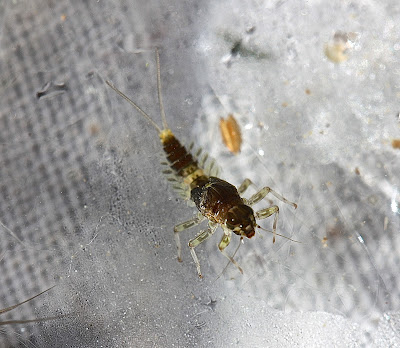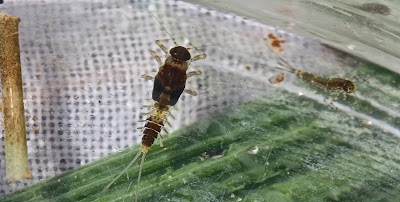Monday, July 2, 2012
Heterocloeon curiosum Rules in the Rivanna: Some Special Pictures
We lost power late Friday night -- the "derecho" hit Charlottesville hard -- but that didn't stop me from going to the Rivanna on Saturday morning. Still, this entry had to wait; our power just came back on this morning.
I'm focussed at the moment -- you've probably guessed -- on small minnow mayflies (Baetidae), and that for a couple of reasons. First, there are a lot of them in our streams at this time of the year and, of greater importance, a lot of different species. I've already found one species I had not seen before -- Iswaeon anoka (see the entry of 6/25) -- and I will not be surprised to find more. Second, they are the "prettiest" insect we see in the summer in terms of colors and patterns. I am seeing a lot of flatheaded mayflies, mostly genus Maccaffertium, but they're all pretty drab, and they're too small for me to ID to the level of species. There are small, "common stoneflies": they too are lacking in color and pattern at this stage of the game. Common netspinners, yes, green and brown, and some small brushlegged mayflies -- but that's about it. I will soon start to go after the "dragons and damsels" that are common in the Rivanna in summer, and I will be posting photos of them. But, at the moment, if we want to see color, we collect the small minnow mayflies.
Well, you say, that small minnow at the top of the page is not a very colorful nymph. True. But it's the largest H. curiosm small minnow that I've ever seen, a full 7 mm. It is a female, and as we saw with the Heterocloeon amplum nymphs we collected in the winter (photo at the end of this entry), the females are plainer in color than are the males -- but in both cases the females are bigger. The male in the photo below was 6 mm, and note that it's fairly mature. (Beaty -- "The Ephemeroptera of North Carolina," p. 9 -- notes, by the way, that H. curisom nymphs are "sexually dimorphic."
In both of these photos, we can see one of the things that is distinctive of the nymphs of this species: the gray pigmented spot in the center of each of the gills. But I also got a spectacular photo of the underside of the female in which you can actually see the procoxal gills and the labrum. The procoxal gills are the white, fingerlike projections at the base of the front legs.
Pretty neat -- no microscope needed. Since almost all of the small minnows I picked up on Saturday's trip were H. curiosum, let me show you a few more of the photos I took -- photos of both female and male.
In this photo (directly above), you see a different small minnow nymph in the upper right of the photo. That's one of two Baetis pluto nymphs that I found. And here's a close look at that insect. Note the three caudal filaments (tails).
Finally, I found yet a third small minnow species, but I failed to preserve this nymph for species ID, assuming that it was just a different colored H. curiosum. It clearly was not. Two things scream Acentrella to me: the paired, submedian dots on the abdominal segments and the two, unbanded caudal filaments. It's probably A. turbida even though it seems rather late in the season to see them.
Turned out to be a great day for photos. Below: female (top) and male (bottom) Heterocloeon amplum small minnow nymphs found in the winter.
Subscribe to:
Post Comments (Atom)










No comments:
Post a Comment